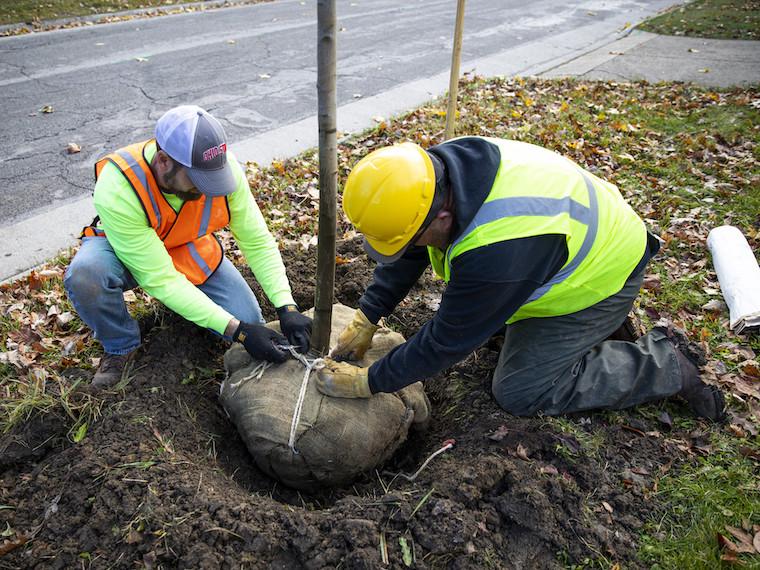Tree Replacement This Week with Removals Scheduled for January
November 29, 2022
Office of Communications

Photo credit: Rebecca Devereaux
Oberlin College and Conservatory took ambitious steps toward carbon neutrality over the past two years, with the campus-wide conversion to geothermal heating and cooling, positioning the institution as a national leader in clean energy. Oberlin’s drive toward carbon neutrality will continue this spring with the third phase of construction for the Sustainable Infrastructure Program (SIP). Removing and replacing trees is necessary to upgrade the existing steam pipes with new low temperature hot water and chilled water pipes for the new geothermalenergy system. This week trees are being planted after the completion of year two construction. To continue to make way for efficient transmission of geothermal heating and cooling, select trees will be removed on campus the first week of January 2023.
Engineers have worked with the grounds department and our campus arborist to make every effort to route the energy system distribution pipes on a path that will cause the least disruption to healthy trees. Sixty (60) trees have been identified for removal in January, with a greater than 1 for 1 replacement ratio. The work will take place mostly in the area of north campus along North Professor Street and Lorain Street with a few trees being removed from the east side of Woodland Street. On North Professor, trees will be removed between Lorain Street and Union Street. On Lorain Street trees will be removed between North Professor and Woodland Street. The trees impacted on Woodland Street are located immediately north of Lorain Street.
Trees are an important aspect of the Oberlin campus and community and the trees that are being removed this winter will be replaced with 74 trees in the fall of 2023. New trees will be selected with a wide range of considerations—such as the city’s tree replacement guide, Ohio native species, interplay of diverse species, structural integrity of a species, and aesthetics. College officials say that when the project is complete, Oberlin's trees will be hardier, more sustainable, and more appropriate to the region than when the project began. To learn more about tree selection, read the campus news article from December 2021, “Phase One of SIP Project Ends with a Campus and City Tree Planting.”
A portion of the wood from removed trees hasbeen identified for reuse on campus in a project to be determined by students and community members.
To learn more about carbon neutrality and SIP visit Oberlin College’s Sustainable Infrastructure Program.
You may also like…
Josh Nolan Named Vice President, General Counsel, and Secretary at Oberlin
Distinguished attorney brings extensive experience in higher education law.
Learning by Teaching: Oberlin Students Share Global Music with Young Learners
College and Conservatory students in PACE 103 prepare local children for an immersive community concert at Oberlin.
Nuiko Wadden ’02 Joins Oberlin Conservatory Faculty as Assistant Professor of Harp
The versatile musician brings extensive opera, orchestral, and contemporary music experience to her role


